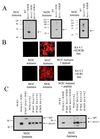A mechanism for ATP-sensitive potassium channel diversity: Functional coassembly of two pore-forming subunits
- PMID: 11136227
- PMCID: PMC14656
- DOI: 10.1073/pnas.98.2.729
A mechanism for ATP-sensitive potassium channel diversity: Functional coassembly of two pore-forming subunits
Abstract
ATP-sensitive potassium channels are an octomeric complex of four pore-forming subunits of the Kir 6.0 family and four sulfonylurea receptors. The Kir 6.0 family consists of two known members, Kir 6.1 and Kir 6.2, with distinct functional properties. The tetrameric structure of the pore-forming domain leads to the possibility that mixed heteromultimers may form. In this study, we examine this by using biochemical and electrophysiological techniques after heterologous expression of these subunits in HEK293 cells. After the coexpression of Kir 6.1 and Kir 6.2, Kir 6.1 can be coimmunoprecipitated with isoform-specific Kir 6.2 antisera and vice versa. Coexpression of SUR2B and Kir 6.2 with Kir 6.1 dominant negatives at a 1:1 expression ratio and vice versa led to a potent suppression of current. Kir 6.1, and Kir 6.2 dominant negative mutants were without effect on an inwardly rectifying potassium channel from a different family, Kir 2.1. Single-channel analysis, after coexpression of SUR2B, Kir 6.1, and Kir 6.2, revealed the existence of five distinct populations with differing single-channel current amplitudes. All channel populations were inhibited by glibenclamide. A dimeric Kir 6.1-Kir 6.2 construct expressed with SUR2B had a single-channel conductance intermediate between that of either Kir 6.2 or Kir 6.1 expressed with SUR2B. In conclusion, Kir 6.1 and Kir 6.2 readily coassemble to produce functional channels, and such phenomena may contribute to the diversity of nucleotide-regulated potassium currents seen in native tissues.
Figures





References
-
- Jan L Y, Jan Y N. Annu Rev Neurosci. 1997;20:91–123. - PubMed
-
- Nichols C G, Lopatin A N. Annu Rev Physiol. 1997;59:171–191. - PubMed
-
- Li M, Jan Y N, Jan L Y. Science. 1992;257:1225–1230. - PubMed
-
- Isacoff E Y, Jan Y N, Jan L Y. Nature (London) 1990;345:530–534. - PubMed
-
- Sheng M, Liao Y J, Jan Y N, Jan L Y. Nature (London) 1993;365:72–75. - PubMed
Publication types
MeSH terms
Substances
Grants and funding
LinkOut - more resources
Full Text Sources

